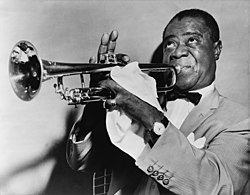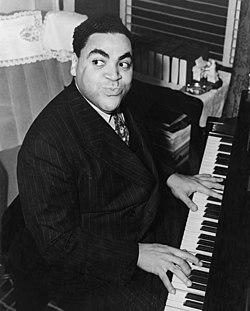
| Jazz standards and tunes |
|---|
| Before 1920 |
| 1920s |
| 1930s |
| 1940s |
| 1950s and later |
| A–Z of jazz standards and tunes |
Jazz standards are musical compositions that are widely known, performed and recorded by jazz artists as part of the genre's musical repertoire. This list includes compositions written in the 1920s that are considered standards by at least one major book publication or reference work. Some of the tunes listed were already well-known standards by the 1930s, while others were popularized later. The time of the most influential recordings of a song, where appropriate, is indicated on the list.
Contents
A period known as the "Jazz Age" started in the United States in the 1920s. Jazz had become popular music in the country, although older generations considered the music immoral and threatening to old cultural values. [3] Dances such as the Charleston and the Black Bottom were very popular during the period, and jazz bands typically consisted of seven to twelve musicians. Important orchestras in New York were led by Fletcher Henderson, Paul Whiteman and Duke Ellington. Many New Orleans jazzmen had moved to Chicago during the late 1910s in search of employment; among others, the New Orleans Rhythm Kings, King Oliver's Creole Jazz Band and Jelly Roll Morton recorded in the city. However, Chicago's importance as a center of jazz music started to diminish toward the end of the 1920s in favor of New York. [4]
In the early years of jazz, record companies were often eager to decide what songs were to be recorded by their artists. Popular numbers in the 1920s were pop hits such as "Sweet Georgia Brown", "Dinah" and "Bye Bye Blackbird". The first jazz artist to be given some liberty in choosing his material was Louis Armstrong, whose band helped popularize many of the early standards in the 1920s and 1930s. [5]
Some compositions written by jazz artists have endured as standards, including Fats Waller's "Honeysuckle Rose" and "Ain't Misbehavin'". The most recorded 1920s standard is Hoagy Carmichael and Mitchell Parish's "Stardust". [6] Several songs written by Broadway composers in the 1920s have become standards, such as George and Ira Gershwin's "The Man I Love" (1924), Irving Berlin's "Blue Skies" (1927) and Cole Porter's "What Is This Thing Called Love?" (1929). However, it was not until the 1930s that musicians became comfortable with the harmonic and melodic sophistication of Broadway tunes and started including them regularly in their repertoire. [4]


